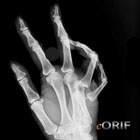|


|
synonyms: MP dislocation, metacarpal phalangeal dislocation
MCP Dislocation ICD-10
- S63.265A Dislocation metacarpophalangeal joint left ring finger, initial
- S63.114A Dislocation metacarpophalangeal joint right thumb, initial
- S63.260A Dislocation metacarpophalangeal joint right index finger, initial
- S63.266A Dislocation metacarpophalangeal joint right little finger, initial
- S63.115A Dislocation metacarpophalangeal joint left thumb, initial
- S63.261A Dislocation metacarpophalangeal joint left index finger, initial
- S63.267A Dislocation metacarpophalangeal joint left little finger, initial
- S63.116A Dislocation metacarpophalangeal joint unspecified thumb, initial
- S63.262A Dislocation metacarpophalangeal joint right middle finger, initial
- S63.268A Dislocation metacarpophalangeal joint other finger, initial
- S63.263A Dislocation metacarpophalangeal joint left middle finger, initial
- S63.269A Dislocation metacarpophalangeal joint unspecified finger, initial
- S63.264A Dislocation metacarpophalangeal joint right ring finger, initial
A- initial encounter
D- subsequent encounter
S- sequela
MCP Dislocation ICD-9
- 834.01(closed)
- 834.11(open)
MCP Dislocation Etiology / Epidemiology / Natural History
- Result from fall on the outstretched hand.
MCP Dislocation Anatomy
- Volar plate, deep transverse metacarpal ligament may present barriers to reduction
- See Hand Anatomy.
MCP Dislocation Clinical Evaluation
- Generally have obvious pain and deformity of the MCP and PIP joint.
- Reducible dorsal dislocation: proximal phalanx is perched in hyperextension with PIP flexion.
- Irreducible dorsal dislocation:proximal phalanx is dorsal to the metacarpal shaft in bayonet position.May have dimpling of the palmar crease skin
- Volar dislocations: Palpabl depression dorsally just proximal to the base of the proximal phalanx. May have active MCP flexion.
- No active nor passive motion
is possible.
- Document neurovascular status of the finger before and after any reduction.
MCP Dislocation Xray / Diagnositc Tests
- A/P, oblique and lateral of affected digit. Widened joint space, or sesamoid bone within the widened MCP joint indicates an irreducible dislocation.
MCP Dislocation Classification / Treatment
- Dorsal: unlikely to be reduced closed due to interpostion of the volar plate or buttonholing of the MC head between the flexor tendons and radial lumbrical. Open reduction: dorsal incision, split extensor tendon, divide volar plate longitudinally to allow reduction.
- Complex dislocation is characterized by bayonet apposition best seen on lateral view. Volar plate has been tramatically avulsed from its origin on the metacarpal with displacement into the MCP joint. Irreducible by closed means. Open reduction can be done by dorsal or palmar approaches. (Becton, JBJS 57A:698;1975).
- Thumb MCP Dislocation S63.116A
MCP Dislocation Associated Injuries / Differential Diagnosis
- Gamekeepers thumb
- PIP dislocation
- Phalangeal Base Fracture
- Phalangeal Neck Fracture
- Distal Phalanx Fracture
- Mallet finger
MCP Dislocation Complications
- Tendon adhesion / stiffness
- Flexion Contracture
- Nerve or vascular injury
- Loss of reduction
MCP Dislocation Follow-up Care
- Post-op /Initial: Splint. Elevation.
- 7-10 Days: xray to ensure reduction is maintained. Activity modifications. Buddy tape digits. Mobilize as soon as possible.
- 6 Weeks: Continue activity modifications. Agressive ROM.
- 3 Months: Resume full activities. Assess ROM.
- 1Yr: assess outcomes / follow-up xrays.
MCP Dislocation Review References
- Rockwood and Greens
- Greens Hand Surgery
|

